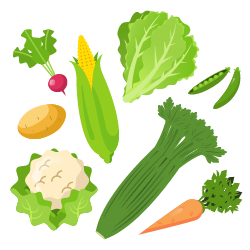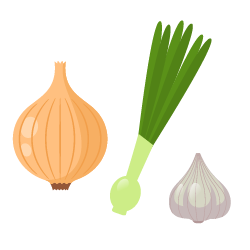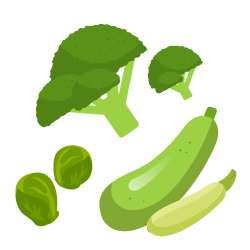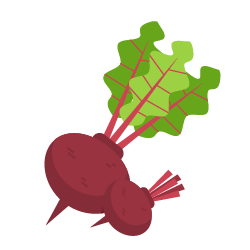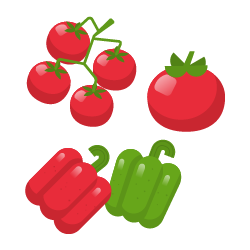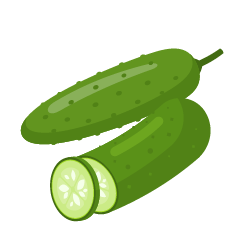Drip Watering Tips to Keep Your Vegetable Garden Thriving All Summer
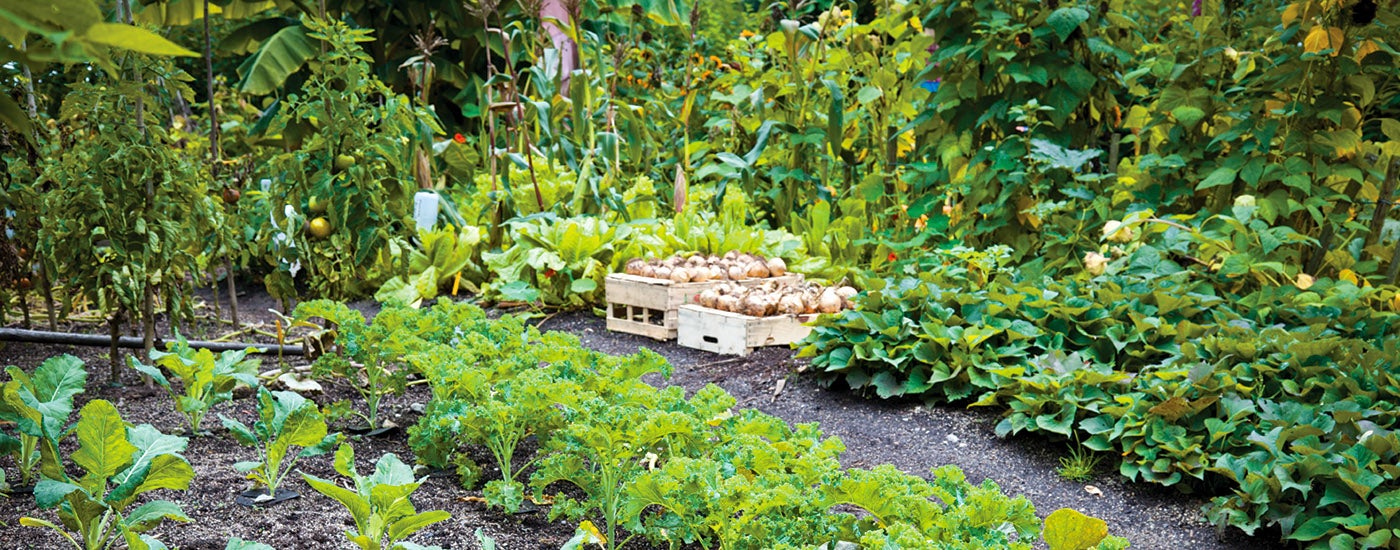
Summer is a great time to spend in the garden, and it's especially nice when your plants are thriving. If you're looking for ways to keep your vegetable garden healthy and happy all season long, a drip irrigation system will enable you to water your plants more effectively while conserving water. Here are some helpful drip watering tips to keep your plants green and your wallet full.
For home gardens, nothing beats the simplicity of drip irrigation to keep plants growing and producing. One of the best things about these easy-to-connect watering systems is that you can target the moisture exactly as needed in each area of the garden, resulting in healthier plant growth from seeding stage all the way through the season as you enjoy the fruits of your labor.
What Are the Best Drip Devices for A Garden?
Drip devices are designed with different water flow rates (expressed as GPH – Gallons Per Hour). From the watering guide below, for example, you might choose a staked 1 GPH dripper to water a summer squash plant which needs about 1 gallon of water per week in warm, humid climates.
From that same watering guide, we also see that squash likes the soil to be kept somewhat moist. So rather than flood the soil, a good rule of thumb would be to water squash twice per week as a general schedule, 30 minutes each time or longer in hot, dry periods.
While there are many specialty drip watering devices, the three main types used in vegetable gardens are:
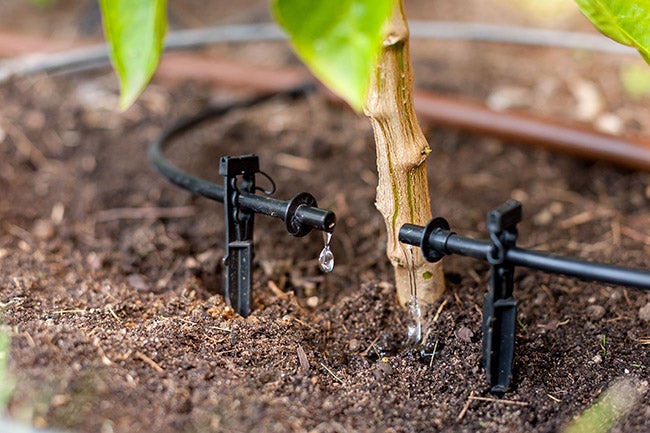 |
Staked Drippers
|
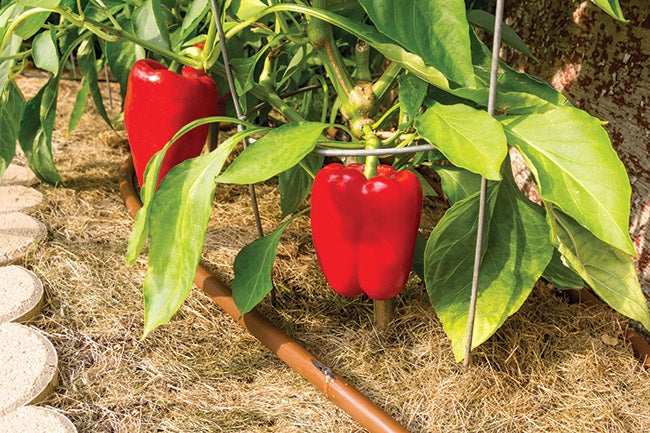 |
Emitter Tubing with Built-In Drippers
|
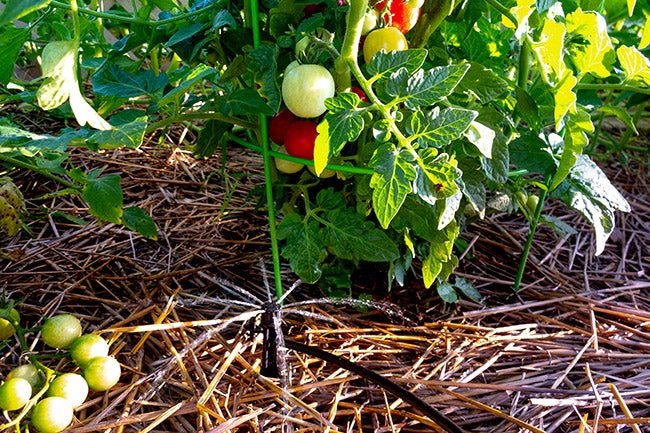 |
Micro Bubblers
|
Micro Sprays and Misters are a fourth type. But for gardening uses, they should be adjusted down to lowest flow rate to direct the watering to smaller areas. Otherwise, they tend to apply water to the surrounding soil, encouraging weed growth. Commonly mounted on risers for wide area coverage of taller plants, another disadvantage of micro sprays is that the water goes onto the whole plant including the leaves. If you use micro sprays in your garden, a good rule of thumb is to schedule watering in early morning or late afternoon so that the water can evaporate from the leaves, avoiding fungal growth.
Before You Lay Out Your Garden Plants
While many gardeners have strong convictions about how they like to locate plants in their garden design, we offer this additional layout tip as an optional consideration. Along with planning your plant spacing and arrangement based on ease of maintaining your garden, also think about where you will be locating the drip tubing and devices throughout the garden.
When planning any drip system for a garden, note that emitter tubing is generally best for row plants that have similar watering needs. This rugged tubing is easy to stake down in straight runs or loops. With its built-in emitters spaced every 12" or 18" and watering evenly at every point, emitter tubing is a good choice for plants that need roughly the same amount of water. Examples: carrots and radishes. Placing them in the same row and watering them with emitter tubing makes perfect sense for water scheduling.
For other plants with differing water needs, consider using a combination of staked¬ drippers and micro bubblers. Because they allow fine tuning of flow rates, these handy devices allow the most options for watering customization. They can be routed easily with ¼" tubing to the root zone of individual plants. For drippers, select low flow-rate types (0.5 or 1.0 GPH) for onions and other plants that need less than 1 gallon of water per week after early stages. Use higher flow-rate drippers (2.0 GPH or 5.0 GPH) and micro bubblers for plants that need more water as noted in the table below. You can also substitute higher flow devices for use in sandy soil.
Drip Watering Guide for Vegetable Gardens
Notes:
- Watering times listed are based on well composted soil with average consistency and drainage.
- For sandy soil, which drains quickly, increase watering duration and frequency.
- For hard-packed clay soil, reduce watering duration to avoid drowning your plants.
- Some plants such as squash and carrots like soil that stays moist 4-8 inches below the surface. To encourage root growth, it is better to water those plants deeply once a week rather than light watering multiple times.
| Plant Types | Watering Devices | Water Needs per week | Cool Climate | Warm/Humid Climate | Hot/Arid Climate | |
|
Row Plants: Cauliflower, celery, corn, lettuce, parsnips, peas, potatoes, radishes, spinach
|
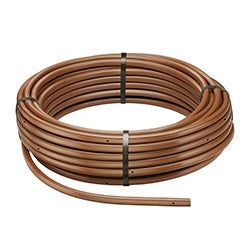 |
½" Emitter Tubing 0.9 GPH 12-inch or 18-inch spacing | 2 gallons | 45 min. (2x/wk) | 60 min. (2x/wk) | 90 min. (2x/wk) |
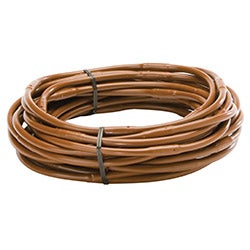 |
¼" Emitter Tubing 1.0 GPH 6-inch or 12-inch spacing Best for shorter tubing runs, less than 30 feet. |
|||||
|
Onions
|
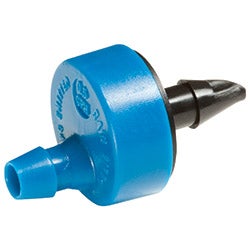 |
Dripper 0.5 GPH | .5 to 1 gallons | 45 min. (1x/wk) | 60 min. (1x/wk) | 90 min. (2x/wk) |
|
Broccoli, brussel sprouts, squash
|
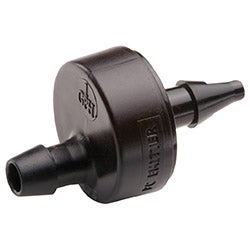 |
Dripper 1.0 GPH | 1 to 1.5 GPH | 45 min. (1x/wk) | 60 min. (1x/wk) | 75 min. (1x/wk) |
|
Beets
|
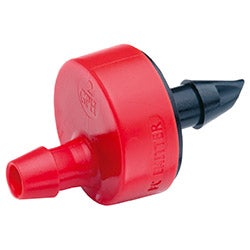 |
Dripper 2.0 GPH | 1 gallon | 45 min. (1x biweekly) | 60 min. (1x biweekly) | 75 min. (1x biweekly) |
|
Tomatoes, peppers
|
Dripper 2.0 GPH | 2 gallons | 45 min. (2x/wk) | 60 min. (2x/wk) | 75 min. (2x/wk) | |
|
Cucumbers
|
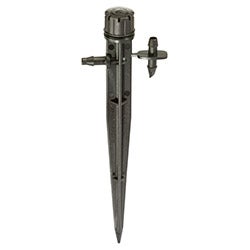 |
Micro Bubblers Adjustable 0-13 GPH | 1 gallon | 45 min. (1x/wk) | 60 min. (1x/wk) | 90 min. (2x/wk) |
|
Beans
|
2 gallons | 45 min. (1x/wk) | 60 min. (1x/wk) | 75 min. (1x/wk) | ||
As plants mature, be sure to check them periodically for signs of dryness. It is likely that hotter, dryer days will indicate a need for increased watering. If you have your garden layout planned in sections by watering rates as noted above, you may be able to increase or decrease watering simply with a single adjustment for the entire garden.
Advanced Control Tips
- Add a manual shutoff valve to stop flow in a section that is getting too wet. Valves are available to fit ¼" as well as ½" tubing.
- Connect your drip system to a hose-end timer to automate your drip irrigation system or soaker hose for better scheduling consistency and worry-free watering convenience.
- Save this watering guide for reference when you are ready to set up and schedule your drip watering system.
With a little planning, it’s easy to install a drip system in your garden that will keep everything well-hydrated and looking great all season long. Ready to get started? Shop our online store for all the drip irrigation components you need to get your garden growing!
